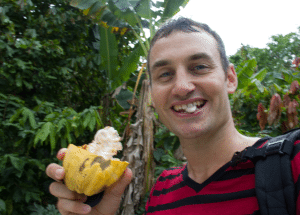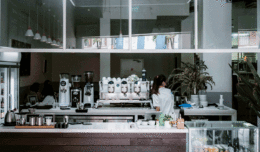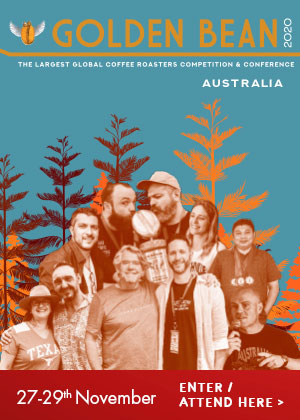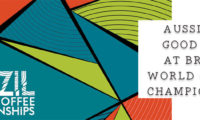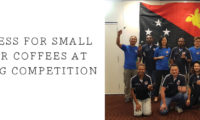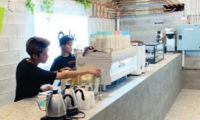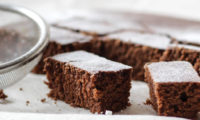Earlier this year, I went on a discovery mission to South America to learn more about cocoa. My travels took me to the tropical mountainous coast of Venezuela and to the lush cocoa farms of central Colombia.
The cocoa is grown by the people of Chuao as a collective. There are no fences dividing the land, and everyone works together to do the work that needs to be done. The cocoa trees grow freely in cleared tropical rain forest around the town. The large cacao pods grow plentifully, protruding from the trunks of the trees in beautiful red green and yellow colours.
Once cut open, the cacao pod reveals fleshy mucilage seeds. You can eat the flesh that surrounds the seeds – it tastes a little bit like mangosteen pulp, a sweet, citric sort of taste. For cocoa manufacturers, however, the seeds are removed and the pulpy flesh left intact. The slimey beans are placed in large troughs and covered with plantain, where they are left to ferment for 3 days, rotating them between troughs on an occasional basis, to ensure that they ferment evenly.
After fermentation, the cocoa beans are laid down in the town centre square in front of the village church. For hundreds of years, this has been the place where the village dries the cacao. Depending on the weather, the beans will be left to dry on the concrete in the warmth of the tropical sun for 3 to 4 days.
Once dried, the cacao beans are primarily taken to the larger town, Occumare, where specialised equipment exists at larger processing plants to separate the cacao into cocoa butter, cocoa liquor and cocoa powder. A small amount of cocoa is also kept by the villagers of town and converted into raw chocolate to sell to passing tourists.
I was able to try some of the raw chocolate products made by the local villagers. The chocolate I tried had a coarse, flaky texture, was really gritty and really bitter, and the flavour was really intense. Typically chocolate is conched, refined, alkalised, and milk powder and sugar is added. I got the distinct impression the chocolate I was eating had undergone very little alteration.
I was also fortunate to try Guarapita. Guarapita is a traditional drink from Choroni on the central coast of Venezuela. It’s made from white rum, cacao, sugar and milk. It reminded me of mum’s chocolate cake mixture before the cake is cooked. It was so good. I bought a bottle, but it didn’t make it back to Australia…
A week later, I headed to my second cocoa plantation visit, where I would learn more about cocoa farming and production. The cocoa farm was located near the town of Socorro in the state of Santander in Colombia. Santander is a place of great historical significance to Colombia, as it was where the upheaval began as the Colombians sought their independence from the Spanish. Socorro is around about 400 years old. In the centre of the town stands a beautiful big church that overshadows a central park, in which the statue of Jose Antonio Galant (who led the rise against the Spanish) is located. Soccoro is surrounded by rich farming land, producing up to 40% of the state of Santander’s coffee. They also grow some high quality cacao in the region.
We travelled by car to a small village called Cinco Guapitan, a full hour’s drive by car on roads that have not seen a grader in a long time. We visited the Hodea Cocoa farm and met with the farm’s caretaker, Omar, who showed us around the property. Omar pointed out the different colour cacao pods growing on the same tree. He explained that the yellow ones had reached a level of ripeness and were ready to be picked. He showed me some other criollo pods that were red in colour and were a different strain or a different variety. The cocoa was an original cultivar from the region.
Pruning is a really important part of maintaining the cacao tree. Generally they’ll be allowed to grow up to a height of about 3 metres. To prevent the tree from growing any higher, which would otherwise prevent the cacao from growing productively, they trim any vertical growing branches, to ensure that a flat, level surface is maintained at the top of the tree, so that even shade and even sun distribution happens across all the cacao pods.
The cacao pods grow from the trunk of the tree continuously throughout the year. There’s not a cropping cycle or a season. Each tree is continuously producing cacao pods, and inside each pod is about 50 to 70 beans, all closely coupled with each other covered in that mucilage. When these are processed, dried and fermented, 50 of these pods will produce around 6 kilograms of finished beans.
Ripe pods are taken back to a small processing plant, where they are cut open to reveal the pulpy mucilage of the beans. This slimey mucilage is actually what ends up fermenting. So during the fermentation process, this is when the flavour of the beans is developing, after which they’re dried and the outer skin removed through a process of winnowing. From winnowing, the beans are rolled through a wet roller. This is to basically break down the bean into a form where the oils and everything will be released. This will create a mass. That mass can then be separated into cocoa butter and cocoa powder, which you should be familiar with in your drinking products.
The cacao beans give of a rich, pungent aroma during the fermentation process. For 4 days the beans are fermented here, and every 2 days they are rotated. After the 4 days, the fermented cacao is spread out; the thick, slimey mucilage that covers the beans is now really sticky. They are spread evenly on a flat, concrete surface, which is heated by the sun. They’re left to dry for about 3 days, so they dry through to the centre. Any moisture that might be contained within the bean could otherwise cause the beans to become mouldy at a later stage. Once the beans are dried, they will be sorted according to size, and farmers receive a higher price for the larger beans.
Interested to learn more about cocoa?
www.somage.tv or email me at
nwakeford@somage.com.au
ABOUT THE AUTHOR
Nathan Wakeford is the Managing Director of Somage Fine Foods, a company committed to pioneering improved product quality and knowledge in foodservice venues. Nathan has been a previous chair of the Victorian Chapter of AASCA, a sensory judge and barista championship competitor. Nathan is also a founder of the AustralAsian Specialty Tea Association and a regular contributor to industry publications and media supporting the hospitality industry.


